 1-800-805-5783
1-800-805-5783 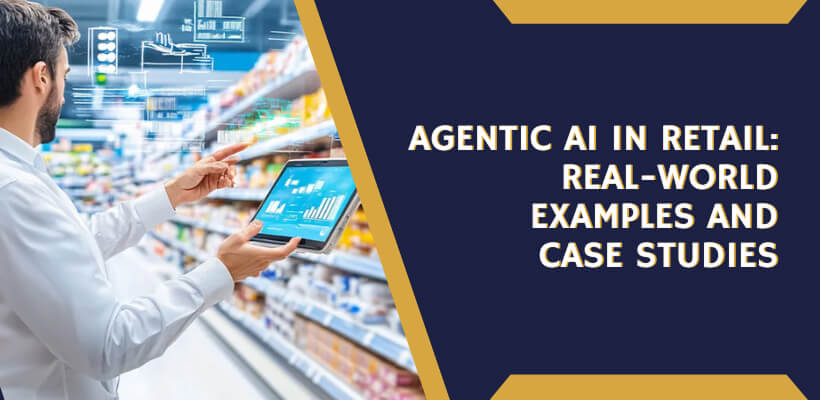
You’ve probably heard the term “agentic AI.” But what does it mean for your retail business? Agentic AI refers to artificial intelligence systems that act autonomously to achieve goals. Unlike traditional automation that follows preset rules, agentic AI in retail observes, learns, reasons, and makes decisions on its own.
You’re not just setting up workflows. You’re handing over real responsibilities to intelligent agents that can adapt, improve, and solve problems in real time.
Why it matters now: In 2024 and 2025, the retail sector has faced pressure from shifting consumer expectations, tighter margins, and relentless competition. According to a 2025 report, 73% of top-performing retailers now rely on autonomous AI systems to handle core business functions.
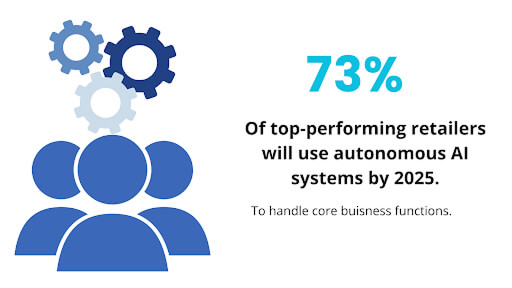
Walmart rolled out agentic AI in several stores to improve how it manages inventory. These systems use computer vision and shelf sensors to monitor product levels. When stock gets low, the AI triggers restocking orders automatically—no middle steps. No delays.
What you gain:
In one pilot store, Walmart cut out-of-stock events by 30% within six months.
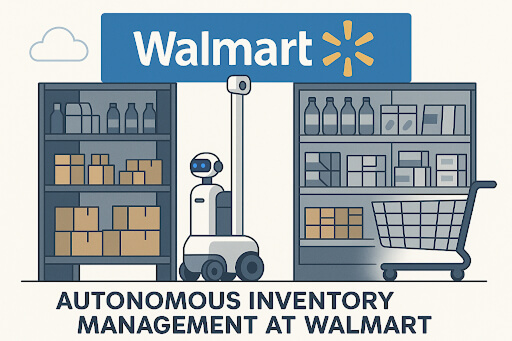
“You can’t win on price alone anymore. You win by having the right product available when the customer wants it. Agentic AI gives us that edge.”
– Doug McMillon, CEO of Walmart (2024 Investor Briefing)
H&M wanted to increase store-level conversions without relying on constant human trials. So they implemented agentic AI in retail to test layout designs based on foot traffic and purchase data.
Each store’s AI system tracks how customers move, what they buy, and how long they stay in different sections. It uses this data to suggest new product placements. Store managers receive daily layout updates that are already optimized for conversion.
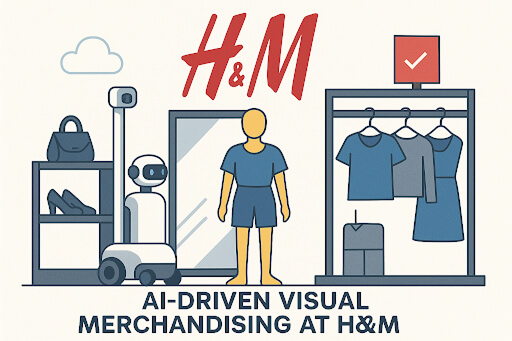
You save time and get better results without micromanaging every decision.
Amazon and Shopify use agentic AI in retail to power shopping assistants that adapt to each customer. These systems learn from browsing history, cart behavior, and even abandoned checkouts.
This is agentic AI in action. You’re not just getting recommendations. You’re getting a shopping experience tailored to your habits without asking for it.
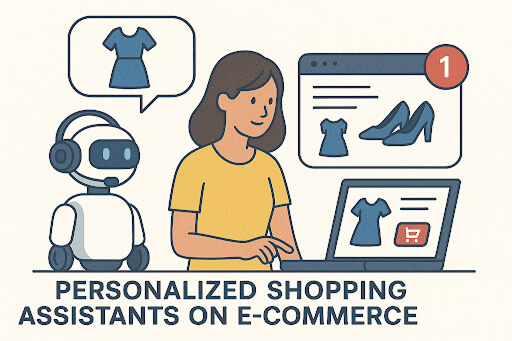
According to Shopify’s 2025 Retail Report, stores that use AI-driven personalization see 25% higher average order values and 19% lower return rates.
Zalando introduced agentic AI in retail to manage pricing dynamically. The agents track sales, competitor prices, and current inventory. Then they adjust prices automatically to stay competitive while protecting profit margins.
You no longer need pricing teams to monitor everything manually. The system adapts instantly.
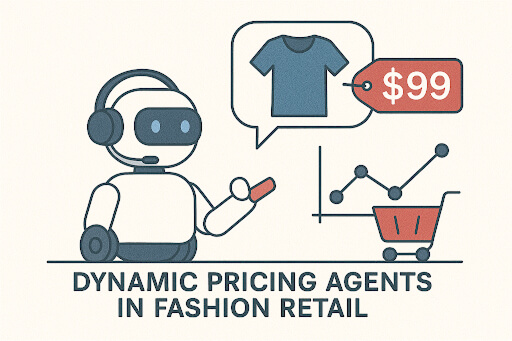
Sephora took agentic AI in retail beyond product recommendations. Their in-store tablets and app now act like digital beauty consultants. When you scan a product or enter your skin tone, the AI suggests the best shade, shows how it looks on your face, and recommends a routine.
Behind the scenes, these systems use data from past purchases, reviews, and seasonal trends. They improve with each interaction.
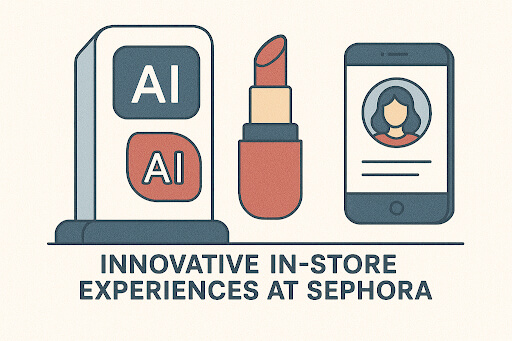
You’re not just adding a new tech feature. When you bring agentic AI into the retail business, you shift the entire operating model. These systems help you move faster, make better decisions, and scale without dragging down quality.
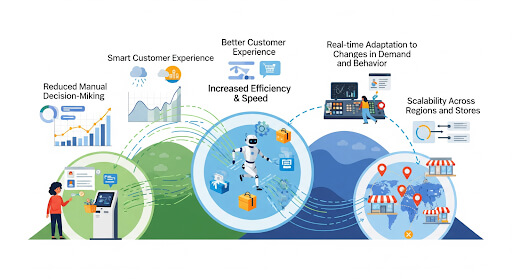
Here’s what you gain:
Agentic AI doesn’t wait for instructions. It acts the moment it detects a need, such as restocking shelves, adjusting prices, or tweaking product recommendations.
That kind of speed cuts hours from workflows. You don’t have to assign tasks or follow up on them. The AI handles them on its own.
Today’s customers expect retail to be fast, personal, and seamless. Agentic AI in retail delivers all three.
It learns from customer actions what they click, skip, or buy and adapts without being told. This means the next time someone shops, the experience is already better.
Why it works: These systems don’t just recommend random products. They build context. So what your customer sees feels relevant, timely, and helpful.
When people get what they want with less effort, they stay longer and spend more.
You can’t rely on weekly reports anymore. Trends shift by the hour.
Agentic AI in retail watches real-time signals: weather, competitor moves, product demand, and social chatter. Then it acts. Price changes. Stock shifts. Promotions launch.
Case in point: During a regional heatwave, a major grocery chain used AI agents to boost promotions on water, fans, and sunscreen within 90 minutes, way faster than any human-led system.
You stay ahead instead of reacting late.
Retail is full of small, repetitive decisions: When to reorder, how much to restock, what item to recommend, which discount to apply. Doing these manually slows you down.
Agentic AI in retail handles them at scale. You set the outcome to maximize margin, reduce returns, and improve satisfaction; the system then figures out the best actions.
Result: Your team doesn’t drown in decisions. They focus on strategy and service.
What works in one store doesn’t always work in another. With traditional tools, scaling personalization or optimization across locations is hard.
Agentic AI in retail solves that. Each system adapts locally while still following your broader goals. You can roll out changes across hundreds of stores or regions and let the AI adjust them to local buying behavior.
Think of it like this: Every store gets smarter on its own while learning from the entire network. You scale without sacrificing relevance or quality.
When you use agentic AI in retail, you change how your business works:

A 2024 McKinsey report found that retailers using autonomous AI grew 50% faster than their competitors. You don’t have to guess what works. The data shows it.
Coming next:
“Agentic AI lets us spend more time solving new problems instead of managing old ones.”
Lina Xu, VP of Innovation, Zalando
You don’t need a massive budget or an army of data scientists to get going. Start by identifying where your store or platform struggles the most. Are there inventory gaps? Slow pricing updates? Weak personalization?
Here’s a simple rollout path:

Once you see early wins, expand to other areas. The key is to treat AI like a teammate, not a replacement. It’s there to do what people don’t have time for.
By the end of 2025, an estimated 85% of enterprises are expected to have implemented some form of AI agents. In the retail sector specifically, 76% of retailers are increasing their investment in AI agents, with a focus on customer service applications.
If you’re still thinking about whether to adopt agentic AI in retail, you’re already behind. Retailers leading the pack have turned AI into a core part of their strategy.
Agentic AI in retail isn’t a maybe. It improves inventory, pricing, layout, and customer engagement. It’s not about removing people. It’s about making your teams faster, more thoughtful, and more focused.
You don’t need to overhaul everything at once. Just start where it hurts the most. Let AI handle the routine, so your team can focus on growth.
Want to stay competitive in 2025? Then it’s time to put agentic AI to work.
1. Is it expensive to implement agentic AI?
The cost depends on your scope. But cloud services and APIs have made it more accessible. ROI often comes in months, not years.
2. Can small retailers use agentic AI?
Yes. Platforms like Shopify and Square already offer agentic features. You don’t need a custom system.
3. What are the risks?
Like any system, poor data or unclear goals can lead to mistakes. But when set up right, agentic AI improves accuracy and speed.
4. Will agentic AI replace human workers?
No. It handles repetitive or data-heavy tasks so people can focus on creativity and strategy.
At [x]cube LABS, we craft intelligent AI agents that seamlessly integrate with your systems, enhancing efficiency and innovation:
Integrate our Agentic AI solutions to automate tasks, derive actionable insights, and deliver superior customer experiences effortlessly within your existing workflows.
For more information and to schedule a FREE demo, check out all our ready-to-deploy agents here.